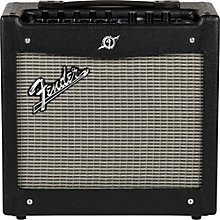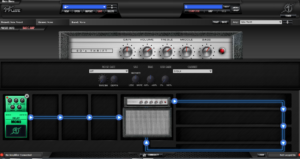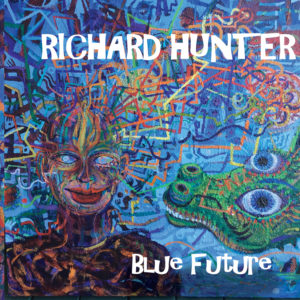
The Fender Mustang II v.2 has arrived–first impressions
I took delivery today on the used Fender Mustang II v.2 amp I bought online from Guitar Center. I paid a total of $146 for this amp shipped; could have saved another $26 by picking it up at the nearest Guitar Center, 45 minutes away, but I’d rather spend the $26 than spend 1.5 hours driving (and burning gasoline) and another half hour in the store.
The amp arrived in very good condition, nice and clean with no obvious scuff or wear marks. When I plugged it in it was dead silent–no crackles or pops–which is what you want to hear from an amp when nothing is plugged in. The amp is also remarkably lightweight for a 40-watter with a 12″ speaker. Better living through electronics…

I immediately found an appropriate USB cable in my collection and plugged the amp into my laptop running Fender’s FUSE software. It took me a few minutes to figure out how editing and saving patches to the amp via the FUSE software works, and then I was up and running.
Sounds good more or less immediately
I tried a few Fender amp and cabinet models out, along with some basic bread and butter effects like slapback delay and reverb. I used my Bottle o’ Blues mic because it’s the bluesiest one I own, and also one of the most feedback-prone. I was pleased to see and hear that the amp and cab models sound very different from one another, and that they behave similarly to other modeled amps I’ve worked with. (That’s good for me because the principles I’ve used to develop patches for other devices work here too, which shortens time from first experiments to working tones for harp players.) The BoB mic feeds back plenty when the midrange EQ is cranked up, which is exactly what you’d expect from either a real or modeled amp.
The reverbs and delays sound good, though I need to play around with the delays more to get exactly the sounds I want, and both FX have outrageous amounts of level on tap. You want to know what your tone sounds like when it’s absolutely swimming in reverb, I mean reverb that’s like 20,000-leagues-under-the-sea deep? This is your amp for that. I will obviously not be cranking up the reverb and delay levels to the max in my patches. (Of course, anyone who wants to drown in reverb is welcome to do so on their own.)

The Mustang v.2 has a very serviceable Vibrolux (Fender rotating speaker) effect that will certainly do the job for harp players who want to sound like an organ. The pitch shifter produces low-octave sounds with a big, round tone. It’s too bad that you can’t have both at once, but there you are. At these prices you can’t have everything. A range of other typical guitar FX–chorus, flange, tremolo, etc.–are in the box too, but I haven’t gotten around to those yet.
One very nice feature of the Mustang v.2 is that you can save and recall twelve FX settings separately from an amp and cabinet setup, so you can have your favorite slapback delay or spring reverb (plus a Vibrolux or pitch shifter) ready to go with any amp and cab setup you choose. I will certainly take advantage of that in my programming.
24 tones coming soon to a Mustang v.2 near you
The Mustang v.2 offers 24 programmable locations, so that’s how many patches will be loaded into my first set. I wouldn’t call this amp difficult to use, but it’s certainly more complex than a typical tube amp coupled with a reverb or delay pedal. That said, 24 patches is plenty enough to provide harp players with a range of useful tones, and the ability to manage FX and modeled amps separately is a big plus. In the end, players using my patch set for these devices will need to know what a couple of different knobs do, and that should be easy enough.
Stay tuned for more news on this patch set as it develops.
If you liked that, you’ll like these:
the 21st century blues harmonica manifesto in sound
Get it on Amazon
Get it on iTunes
the rock harmonica masterpiece
Get it on Amazon
Get it on iTunes
Tags In
Related Posts
4 Comments
Leave a Reply
You must be logged in to post a comment.
WHAT’S NEW
Categories
- Audio/Video
- Blog
- Blue Future
- Digitech RP Tricks and Tips
- Discography, CDs, Projects, Info, Notes
- Featured Video
- For the Beginner
- Gallery
- Hunter's Effects
- Hunter's Music
- Huntersounds for Fender Mustang
- Meet the Pros
- More Video
- MPH: Maw/Preston/Hunter
- My Three Big Contributions
- Player's Resources
- Pro Tips & Techniques
- Recommended Artists & Recordings
- Recommended Gear
- Recorded Performances
- Reviews, Interviews, Testimonials
- The Lucky One
- Uncategorized
- Upcoming Performances
- Zoom G3 Tips and Tricks



Hey Richard ~ Be sure and access the “Sag” and “Boost” settings on the Mustang. It’s one of the things that makes the Mustang different (and more authentic IMO) from other modeling amps.
Noted and thanks, any recommendations for settings? You’re right, I’ve never seen those on any other modeling amp.
After an hour or so of experimentation I found bias and sag settings that I liked for particular amps, or particular amp/cab setups.
Hey Richard, have you created patches for the newer models? I just picked up a mustang gt 100, I got some fun work to do setting it up